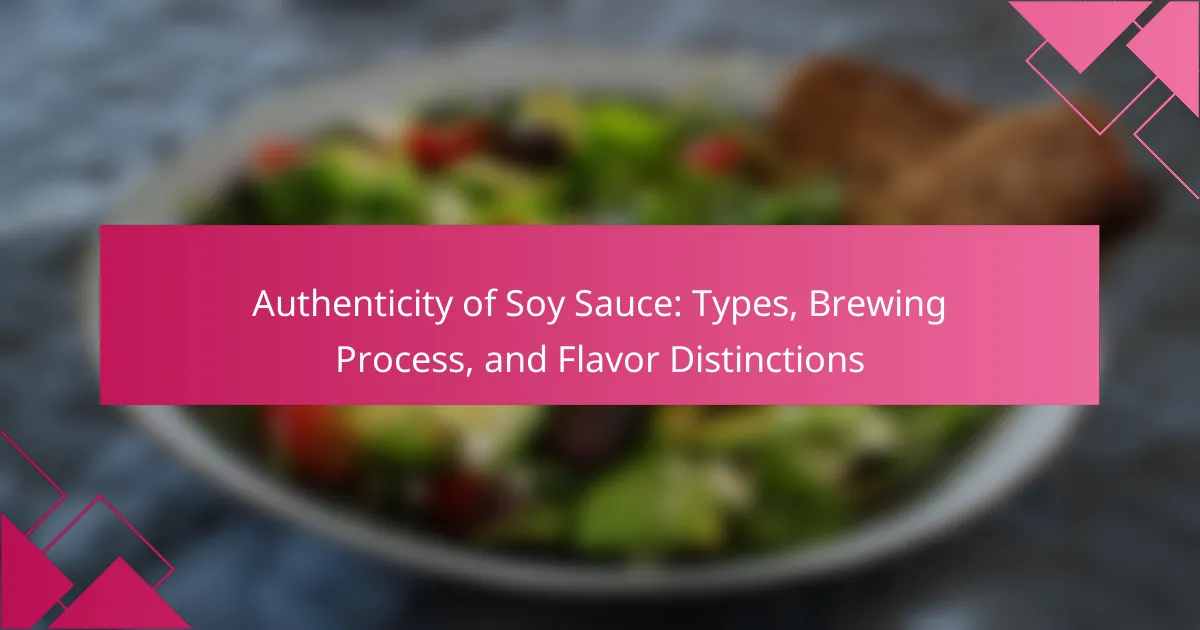
What is the authenticity of soy sauce?
The authenticity of soy sauce refers to its genuine production methods and ingredients. Authentic soy sauce is traditionally brewed through fermentation using soybeans, wheat, salt, and specific cultures. This process can take several months, allowing for complex flavors to develop. In contrast, many commercial soy sauces use shortcuts, such as acid hydrolysis, which produces a less authentic product. Authentic soy sauce varies by region, with distinct flavor profiles in Japanese, Chinese, and Korean varieties. For example, Japanese soy sauce often has a lighter, sweeter taste, while Chinese soy sauce can be darker and saltier. The authenticity can also be verified through certifications and labels indicating traditional brewing methods.
How is soy sauce traditionally defined?
Soy sauce is traditionally defined as a fermented condiment made from soybeans, wheat, salt, and water. It originates from ancient China and has been used for thousands of years. The fermentation process typically involves specific molds, yeasts, and bacteria. This process can take several months to years, depending on the type of soy sauce being produced. Traditional soy sauce is characterized by its rich umami flavor and dark color. It is commonly used in Asian cuisine for seasoning and dipping. The brewing methods vary, with some regions favoring specific techniques that influence flavor profiles. Historical records indicate that soy sauce was first mentioned in texts dating back to the 3rd century AD.
What are the key characteristics of authentic soy sauce?
Authentic soy sauce is characterized by its natural fermentation process, rich umami flavor, and complex aroma. It is traditionally made from soybeans, wheat, salt, and water. The brewing process typically takes several months to years, allowing for the development of deep flavors. Authentic soy sauce contains no artificial additives or preservatives. It has a dark brown color and a slightly viscous texture. The flavor profile includes sweet, salty, and savory notes. High-quality soy sauce often has a balanced acidity. Authentic products are usually labeled as “brewed” or “naturally fermented.”
How does authenticity impact the quality of soy sauce?
Authenticity significantly impacts the quality of soy sauce. Authentic soy sauce is traditionally brewed using whole soybeans, wheat, salt, and specific molds and yeasts. This process takes several months, allowing for complex flavors to develop. In contrast, non-authentic versions may use hydrolyzed soy protein and artificial flavorings, leading to inferior taste and quality. Studies show that traditionally brewed soy sauce contains beneficial amino acids and antioxidants, enhancing its nutritional profile. Authenticity ensures a rich umami flavor, which is often lacking in mass-produced alternatives. Therefore, the brewing method directly correlates with the overall quality and flavor of the soy sauce.
Why is authenticity important in soy sauce production?
Authenticity is crucial in soy sauce production because it ensures the quality and flavor of the final product. Authentic soy sauce is traditionally brewed using specific ingredients and methods, which contribute to its unique taste. The fermentation process, often lasting several months, develops complex flavors that cannot be replicated in synthetic alternatives. Authentic brands adhere to regional standards and practices, preserving cultural heritage. For instance, Japanese soy sauce often uses a combination of wheat and soybeans, while Chinese varieties may differ in ingredients and processing. This distinction affects the aroma, color, and taste of the sauce. Consumers increasingly seek authenticity for both culinary and health reasons, as traditional brewing methods often result in fewer additives and preservatives. The demand for genuine products supports local producers and maintains traditional craftsmanship in soy sauce production.
What are the risks of consuming non-authentic soy sauce?
Consuming non-authentic soy sauce can pose several health risks. These sauces often contain additives and preservatives that may cause allergic reactions. Some non-authentic soy sauces use lower-quality ingredients, which can lead to digestive issues. They may also have high levels of sodium, increasing the risk of hypertension. Additionally, some brands might include artificial flavorings that can be harmful in large amounts. A study by the Journal of Food Science found that certain non-authentic soy sauces contained harmful levels of 3-MCPD and glycidyl fatty acid esters, which are potential carcinogens. Therefore, it is essential to choose authentic soy sauce for both safety and quality.
How does authenticity influence consumer trust?
Authenticity significantly influences consumer trust by establishing credibility and reliability in products. When consumers perceive a product as authentic, they are more likely to trust the brand behind it. Authenticity assures consumers that the product meets their expectations in quality and origin. For instance, a study by the Journal of Brand Management found that 86% of consumers are willing to pay more for brands that demonstrate authenticity. This trust leads to increased customer loyalty and repeat purchases. Brands that communicate their authentic story effectively can differentiate themselves in competitive markets. Authenticity also mitigates skepticism, as consumers feel more secure in their purchasing decisions.

What are the different types of soy sauce?
The different types of soy sauce include light soy sauce, dark soy sauce, tamari, and sweet soy sauce. Light soy sauce is thinner and saltier, commonly used for seasoning and marinades. Dark soy sauce is thicker and sweeter, often used for color and richness in dishes. Tamari is a gluten-free option, made primarily from soybeans, and has a richer flavor. Sweet soy sauce, also known as kecap manis, contains added sugar and is used in Indonesian cuisine for a sweet glaze. Each type has distinct flavors and uses in various culinary traditions.
What are the main categories of soy sauce?
The main categories of soy sauce are light soy sauce, dark soy sauce, and tamari. Light soy sauce is thin, salty, and used for seasoning and dipping. Dark soy sauce is thicker, sweeter, and often used for color and richness in dishes. Tamari is a gluten-free soy sauce made primarily from soybeans, with little to no wheat content. Each category serves distinct culinary purposes, influencing flavor and texture in various recipes.
How do light and dark soy sauces differ?
Light soy sauce is thinner and saltier than dark soy sauce. Light soy sauce is typically used for seasoning and marinades. It has a lighter color and a more pronounced umami flavor. Dark soy sauce, on the other hand, is thicker and sweeter. It is often used to add color to dishes. Dark soy sauce has a richer flavor due to longer fermentation. The brewing process for dark soy sauce includes added caramel for sweetness. Both types are essential in Chinese cuisine, serving distinct culinary purposes.
What is the significance of regional variations in soy sauce?
Regional variations in soy sauce are significant because they reflect local ingredients, production methods, and cultural preferences. Different regions, such as Japan, China, and Korea, have distinct styles of soy sauce. For instance, Japanese soy sauce often uses a higher proportion of wheat, resulting in a sweeter flavor. In contrast, Chinese soy sauce may be darker and saltier due to fermentation processes that vary by region. These variations influence culinary applications and pairings in local cuisines. The diversity in flavors enhances the overall gastronomic experience, allowing for a range of tastes and uses in dishes. Understanding these regional differences is essential for appreciating the authenticity and complexity of soy sauce.
What are the distinguishing features of each type?
The distinguishing features of each type of soy sauce are based on their ingredients, brewing methods, and flavor profiles. Traditional soy sauce is brewed from soybeans and wheat, resulting in a rich umami flavor. Tamari, a gluten-free option, contains little to no wheat and has a deeper, more robust taste. Light soy sauce is saltier and lighter in color, often used for seasoning. Dark soy sauce is thicker, sweeter, and darker, adding color and depth to dishes. Each type serves distinct culinary purposes, enhancing various cuisines. For example, light soy sauce is preferred for stir-frying, while dark soy sauce is ideal for braising.
How does the brewing process affect the flavor of different soy sauces?
The brewing process significantly influences the flavor of different soy sauces. Traditional brewing involves fermentation, which develops complex flavors. The duration of fermentation affects the depth and richness of the taste. Longer fermentation typically results in a more robust flavor profile.
Different soy sauce types, such as light and dark, undergo varying brewing times and methods. Light soy sauce is often brewed for a shorter period, yielding a saltier and lighter flavor. Dark soy sauce, on the other hand, is brewed longer and may include additional ingredients like caramel, enhancing its sweetness and richness.
The use of specific molds and yeasts during fermentation also contributes to distinct flavor nuances. For example, koji mold is essential in traditional brewing, breaking down starches into sugars that add sweetness.
In summary, the brewing process, including fermentation time and ingredient selection, plays a crucial role in shaping the flavor characteristics of various soy sauces.
What role do ingredients play in defining soy sauce types?
Ingredients are crucial in defining soy sauce types. The primary ingredients include soybeans, wheat, salt, and water. Variations in the proportions of these ingredients lead to different flavor profiles and textures. For instance, a higher wheat content results in a sweeter soy sauce. The fermentation process is also influenced by the type of soybeans used. Traditional brewing methods, such as koji fermentation, further differentiate types. Regional variations, such as Chinese and Japanese soy sauces, highlight the importance of local ingredient choices. The quality and source of ingredients can significantly impact the final product’s authenticity and taste.

What is the brewing process for soy sauce?
The brewing process for soy sauce involves several key steps. First, soybeans and wheat are cooked and mixed with a specific mold, usually Aspergillus oryzae. This mixture is then allowed to ferment for a few days. Afterward, the fermented mixture is combined with brine, which is saltwater. This combination undergoes a longer fermentation process, lasting several months to years. The fermentation allows the development of complex flavors and aromas. Finally, the mixture is pressed to extract liquid soy sauce, which is then pasteurized for safety. This process is essential for producing authentic soy sauce with rich taste.
How is soy sauce traditionally brewed?
Soy sauce is traditionally brewed through a fermentation process. This process begins with the mixing of soybeans, wheat, and salt. The mixture is then inoculated with specific molds, typically Aspergillus oryzae. After the initial mold fermentation, water is added to create a mash. Yeast is introduced to initiate alcoholic fermentation. This fermentation lasts several months, allowing flavors to develop. The mixture is then pressed to separate the liquid soy sauce from the solids. Finally, the soy sauce is pasteurized and bottled for consumption. Traditional brewing methods can take several months to complete, ensuring rich and complex flavors.
What are the steps involved in the fermentation process?
The fermentation process involves several key steps. First, substrate preparation occurs, where raw materials like soybeans and wheat are cleaned and cooked. Next, inoculation takes place, introducing specific microorganisms such as molds, yeasts, or bacteria to the substrate. Following this, the fermentation phase begins, where these microorganisms metabolize the sugars in the substrate, producing alcohol, acids, and other compounds. After fermentation, maturation occurs, allowing flavors to develop over time. Finally, filtration and pasteurization are done to remove solids and pathogens, ensuring the final product is safe for consumption. These steps are crucial for producing authentic soy sauce, which relies on controlled fermentation to develop its unique flavor profile.
How does time affect the brewing process and flavor?
Time significantly affects the brewing process and flavor of soy sauce. The duration of fermentation influences the development of flavors. Longer fermentation times typically result in richer, more complex flavors. This is due to the breakdown of proteins and carbohydrates into amino acids and sugars. Shorter fermentation periods may yield milder, less nuanced flavors.
For example, traditional soy sauce can ferment for several months to years. This extended timeframe allows for the growth of beneficial microorganisms. These microorganisms contribute to the flavor profile and aroma of the final product. Studies show that fermentation beyond six months enhances umami characteristics. Therefore, time is a crucial factor in achieving the desired taste and quality in soy sauce.
What modern methods are used in soy sauce production?
Modern methods used in soy sauce production include fermentation, hydrolysis, and pasteurization. Fermentation typically involves using specific molds, yeasts, and bacteria to create umami flavors. Traditional fermentation can take months, but modern techniques may shorten this to days. Hydrolysis, often through acid or enzymatic processes, breaks down soy proteins quickly. This method can produce soy sauce in a matter of hours. Pasteurization is used to eliminate harmful microorganisms and enhance shelf life. Advanced filtration techniques clarify the sauce and improve its appearance. These methods collectively ensure consistent flavor and quality in soy sauce production.
How do industrial processes differ from traditional methods?
Industrial processes for soy sauce production differ from traditional methods primarily in scale and efficiency. Industrial methods utilize modern machinery for fermentation and bottling. This allows for higher production volumes compared to traditional, small-batch techniques. Traditional methods often involve manual labor and longer fermentation times. For example, traditional soy sauce can take several months to brew, while industrial processes can reduce this time significantly. Additionally, industrial processes may use additives to enhance flavor and speed up fermentation. These differences impact the final taste and quality of the soy sauce produced.
What are the implications of using additives in soy sauce?
The use of additives in soy sauce can impact flavor, quality, and health. Additives like preservatives and color enhancers may alter the natural taste. They can also affect the nutritional profile of the product. For instance, some additives may increase sodium levels. This can be concerning for individuals monitoring their salt intake. Additionally, artificial flavorings might mask lower quality ingredients. Authentic soy sauce typically relies on traditional fermentation processes without such additives. Studies show that consumers prefer naturally brewed soy sauce for its rich flavor and health benefits.

How do flavor distinctions vary among soy sauces?
Flavor distinctions among soy sauces vary primarily due to their brewing methods and ingredients. Different types of soy sauce include light, dark, and tamari. Light soy sauce has a saltier flavor and is often used for seasoning. Dark soy sauce is thicker and sweeter, providing a richer color and taste. Tamari, usually gluten-free, offers a more complex umami flavor. The fermentation process also influences flavor; longer fermentation typically results in deeper, more nuanced tastes. Additionally, regional variations, such as Chinese and Japanese soy sauces, contribute to unique flavor profiles. These distinctions are rooted in traditional recipes and practices.
What factors contribute to the flavor profile of soy sauce?
The flavor profile of soy sauce is influenced by multiple factors. The primary factor is the fermentation process, which involves specific molds, yeasts, and bacteria. These microorganisms break down soybeans and wheat, producing amino acids and sugars. The type of soybeans used also significantly impacts flavor, with different varieties offering distinct tastes. Additionally, the length of fermentation affects the depth and complexity of the flavor.
Another contributing factor is the water quality, as mineral content can alter the final taste. The brewing temperature and environment play a role in the fermentation rate and flavor development. Finally, aging in wooden barrels can impart unique characteristics to the soy sauce. These factors collectively shape the overall flavor profile, making each soy sauce unique.
How do fermentation time and temperature influence flavor?
Fermentation time and temperature significantly influence the flavor of soy sauce. Longer fermentation times generally enhance umami flavors. Higher temperatures can accelerate fermentation but may lead to off-flavors. Conversely, lower temperatures can create more complex and refined flavors. Research indicates that optimal fermentation occurs at temperatures around 25-30°C. At this range, beneficial microorganisms thrive, producing desirable flavor compounds. Studies show that variations in time and temperature can alter the balance of sweet, salty, and savory notes. Thus, both factors are crucial in determining the final flavor profile of soy sauce.
What is the impact of different ingredients on taste?
Different ingredients significantly impact the taste of soy sauce. The primary ingredients include soybeans, wheat, salt, and water. Each ingredient contributes unique flavors and aromas. For instance, soybeans provide umami, while wheat adds sweetness. Salt enhances overall flavor and acts as a preservative. The fermentation process further develops these tastes. Variations in ingredient proportions lead to different flavor profiles. For example, a higher wheat content results in a sweeter soy sauce. Additionally, the source of water can influence the final taste. These factors collectively define the authenticity and flavor distinctions of soy sauce.
What are common flavor descriptions for various soy sauces?
Soy sauces have distinct flavor profiles that vary by type. Light soy sauce is typically salty and slightly sweet. It is often used for seasoning and dipping. Dark soy sauce is richer and has a deeper umami flavor. It is less salty and adds color to dishes. Tamari is known for its smooth, rich taste and is usually gluten-free. It has a balanced flavor with less saltiness than regular soy sauce. Sweet soy sauce, or kecap manis, is thick and sweet, often used in marinades and stir-fries. Each type of soy sauce offers unique attributes that enhance different culinary applications.
How do umami and sweetness levels differ among types?
Umami and sweetness levels vary significantly among different types of soy sauce. Traditional soy sauce, especially those brewed naturally, tends to have a pronounced umami flavor due to the fermentation process. This process enhances the amino acids, particularly glutamate, contributing to the umami taste. In contrast, sweet soy sauce, such as kecap manis, has added sugar or sweeteners, resulting in higher sweetness levels.
Light soy sauce is typically saltier and has less sweetness, focusing more on umami. Dark soy sauce, however, is richer and slightly sweeter due to the caramelization of sugars during production. The balance of umami and sweetness is influenced by the brewing method and the ingredients used. For instance, chemically produced soy sauces often lack the depth of flavor found in naturally brewed varieties.
What are the characteristics of soy sauce from different regions?
Soy sauce characteristics vary significantly by region. Japanese soy sauce is typically lighter and sweeter. It often has a delicate flavor profile. This is due to the use of a higher percentage of wheat. Chinese soy sauce is generally darker and saltier. It has a robust flavor, often attributed to fermentation methods. Korean soy sauce, known as ganjang, has a rich, umami taste. It is often made with whole soybeans and less wheat. Indonesian soy sauce, called kecap manis, is sweet and thick. It includes added sugar and spices, providing a unique flavor. Each region’s climate and ingredients influence these differences.
What are the best practices for selecting authentic soy sauce?
Choose soy sauce labeled as “brewed” rather than “chemical” or “artificial.” Authentic soy sauce undergoes fermentation, which enhances flavor complexity. Look for products that list soybeans and wheat as primary ingredients. Check for a brewing time of at least six months, as longer fermentation typically indicates quality. Inspect for a rich, dark color, which is a sign of proper aging. Consider soy sauces that are produced in traditional regions like Japan or China. Avoid those with added preservatives or artificial flavors, as these compromise authenticity. Selecting soy sauce with a clear, sediment-free appearance often indicates quality.
How can consumers identify high-quality soy sauce?
Consumers can identify high-quality soy sauce by examining its ingredients and production method. Authentic soy sauce typically contains only soybeans, wheat, salt, and water. High-quality soy sauce is brewed using traditional fermentation methods, which can take several months. Look for brands that specify “brewed” rather than “chemical” or “artificially flavored.”
The color of high-quality soy sauce is usually a deep brown, indicating proper fermentation. A rich aroma and a balanced flavor profile, with umami notes, are also signs of quality. Labels that indicate the soy sauce is made in Japan or China often suggest authenticity.
Additionally, consumers can check for certifications such as “Kikkoman” or “Tamari,” which are known for high standards. Reading reviews and seeking recommendations from culinary experts can further guide consumers in their selection.
What tips can help in choosing the right soy sauce for dishes?
Choose soy sauce based on its type and intended use. Different types include light, dark, and tamari. Light soy sauce is saltier and ideal for seasoning. Dark soy sauce is thicker and sweeter, suitable for marinades. Tamari is gluten-free and works well for dipping. Check the label for ingredients; authentic soy sauce contains only soybeans, wheat, salt, and fermentation agents. Look for products labeled as ‘brewed’ rather than ‘chemical’ to ensure quality. Aged soy sauce often has a richer flavor. Taste before purchasing; quality varies by brand.
The main entity of the article is soy sauce, focusing on its authenticity, types, brewing process, and flavor distinctions. The article explores the genuine production methods of soy sauce, emphasizing traditional fermentation techniques that contribute to its unique flavor profiles across various regional varieties, including Japanese, Chinese, and Korean. It also discusses key characteristics of authentic soy sauce, the impact of authenticity on quality, and the potential risks associated with consuming non-authentic products. Additionally, the article outlines best practices for selecting high-quality soy sauce and the significance of ingredients and brewing time in determining flavor.
